Chicken tabaka, a famous Georgian dish made by pan-frying butterflied chicken in butter until you get a crispy, dark golden-brown crust while the meat inside is tender and juicy.
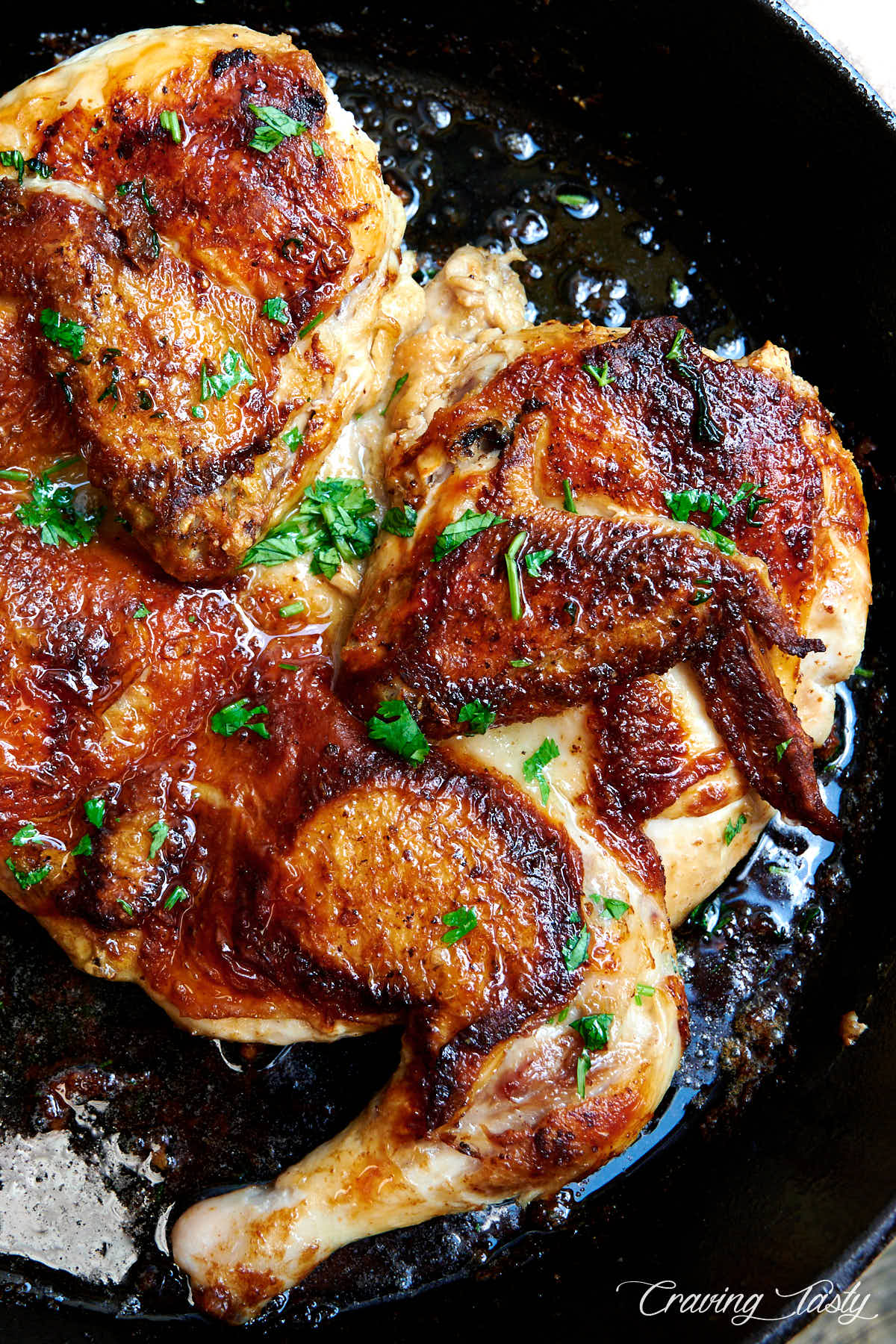
Chicken tabaka, or chicken tapaka, is well-known not only Georgia. It's a popular dish in other Caucasian cuisines as well. Similar to other famous dishes such as kharcho soup, it has become a common restaurant menu item throughout Eastern Europe and Central Asia.
How то маке chicken tabaka
Chicken tabaka is made by butterflying a chicken and frying it slowly in butter on a large skillet called 'tapa' on both sides. Hence the name chicken tapaka or tabaka. The chicken is weighted down by a heavy object. Using butter is imperative as it adds a tremendous amount of flavor. The timing varies depending on the size of the bird and the heat level. Typically, you will need around 20-25 minutes per side.
Some modern recipes suggest adding garlic and rubbing the chicken with traditional spices and hot paprika before cooking. Other, more traditional recipes suggest adding only salt and sometimes red hot chili pepper powder. Feel free to experiment and see what you like but my personal favorite is go with just plain salt.
In general, chicken tabaka is made without any spices as often it will be used as an ingredient to other dishes, e.g. chicken borani. If chicken tabaka is to be served as a dish on its own, it will be accompanied by a flavorful sauce or garlic and herbs liquefied in a mortar. This dish is often served with lots of cilantro, basil, green onions or thinly sliced white onions on the side.
Garlic, whole or crushed, and the spices tend to burn in hot butter and make cooking way more complicated. Very little flavor is left too after the seasoning spend so much time in hot butter. The chicken will be plenty flavorful even without them but if you want more, serve it with the tomato and walnut sauce which will add a ton of rich flavor.
Equipment
For best results the frying pan should have a thick, heavy bottom. Cast iron pans are an excellent choice. Flat bottom pans are ideal as they provide maximum contact with the food.
You will also need a way to press the chicken down during cooking to ensure maximum contact with the cooking surface. Ideally you'd want a pan with a press attachment as shown on the picture below. They are not easy to find outside of Georgia and Eastern Europe though.
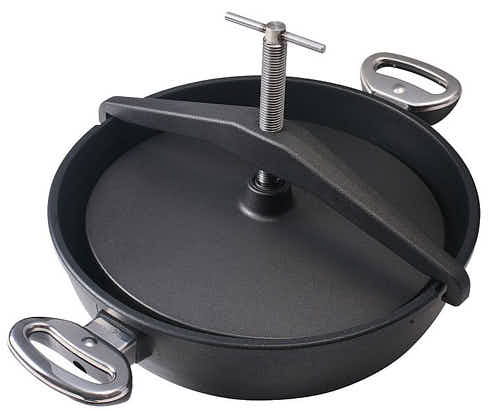
If you can't find one of those, simply place another cast iron pan on top of the chicken. Alternatively, use a pot filled with water. My favorite method is to use a flat cast iron grill press.
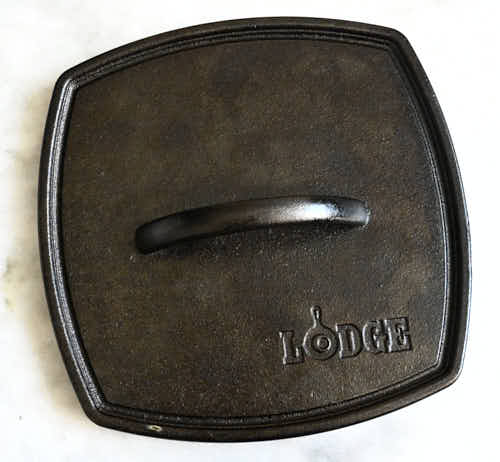
Serving sauces
Crispy on the outside and tender and juicy on the inside, this chicken is a real treat. It's common to serve it with a traditional Georgian plum sauce tkemali.
Another popular sauce to serve with chicken tabaka is the tomato and walnut sauce. Unlike tkemali, the tomato and walnut sauce can be prepared at home quite easily, It's my favorite sauce to serve with this dish.
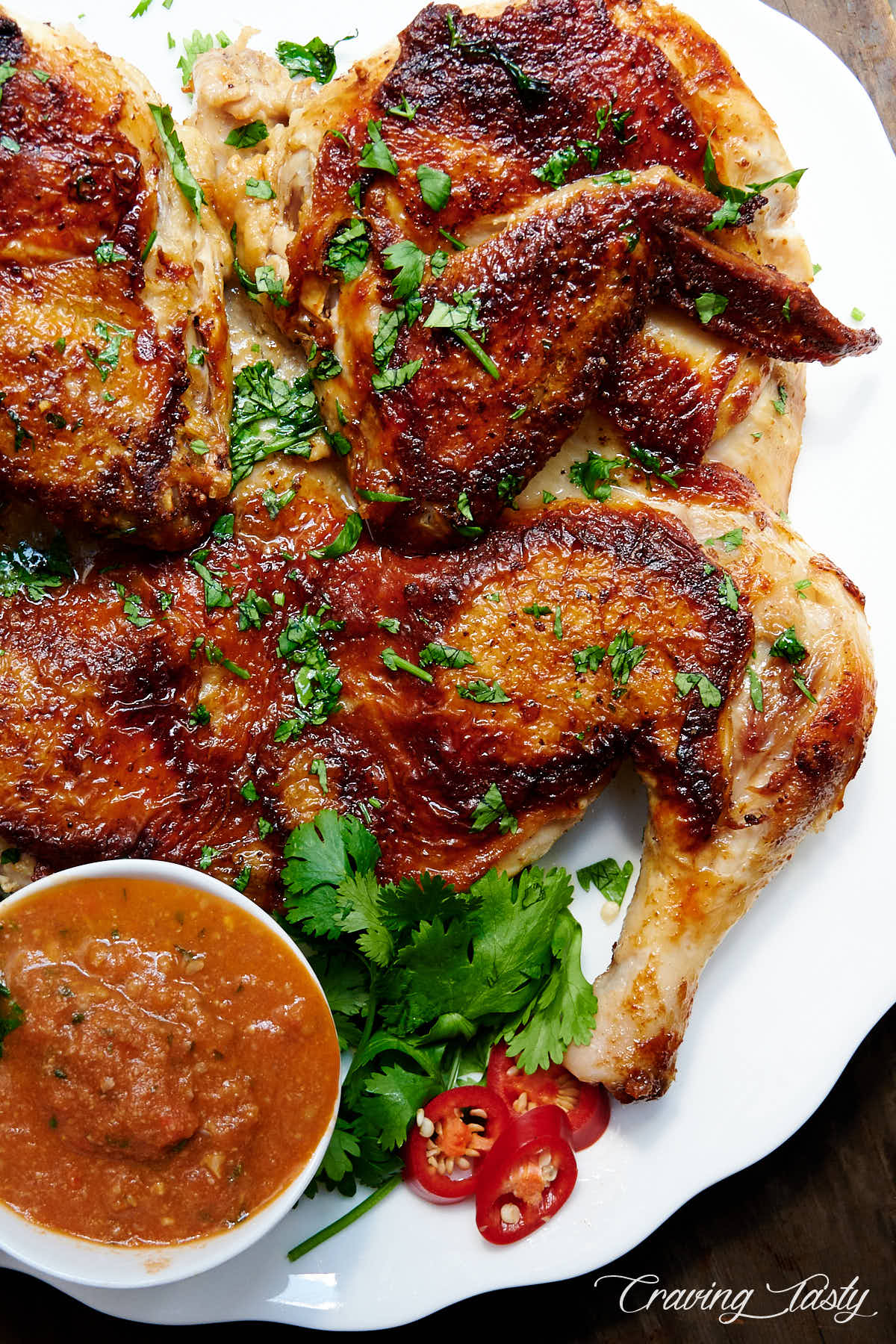
Common side dishes
Serve chicken tabaka with fried potatoes, white rice, fresh tomatoes and cucumbers or a summer salad. Georgians like to serve this chicken with plenty of fresh cilantro on the side too.
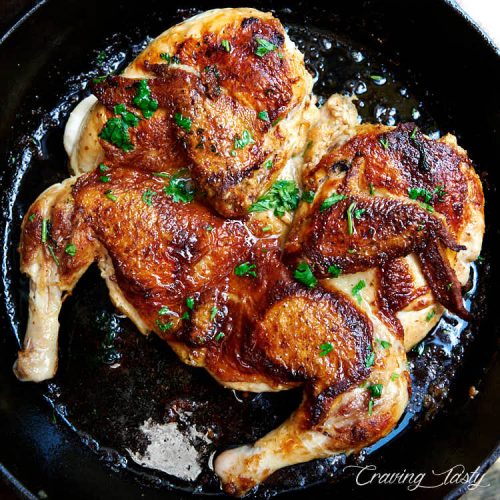
Chicken Tabaka
Ingredients
- 1 whole chicken pick a small, younger chicken, about 2 lbs
- 2 tsp kosher salt plus more to taste
- 6 Tbsp butter clarified or regular
- 1/2 bunch cilantro a mix of chopped and whole, for garnish
For the sauce
- 5 tomatoes about 1 1/4 lbs
- 1/4 cup walnuts
- 1 clove garlic
- 1 red hot chili pepper cut in half, seeded, membrane removed
- Salt to taste
- 1 Tbsp chopped fresh cilantro
Instructions
- Butterfly the chicken by cutting along the breast bone. Place the chicken skin side up on a on a large cutting board, cover with a piece of plastic and pound to flatten. Season with salt on both sides and set aside.
- Heat the butter in a large cast iron skillet over medium-low heat. Place the chicken skin side down on the skillet, weight it down with a heavy object, and fry for 20-25 minutes, until the skin is dark golden-brown. Flip and cook for another 20-25 minutes or until the chicken is cooked through.
- Meanwhile, bring water to a boil in a medium pot. Add the tomatoes and blanch for 1 minute then place in a bowl with cold water and let cool down for a minute. Drain the water and remove skins.
- Place the skinned tomatoes and the rest of the ingredients in a blender and pulse for 15 seconds. Transfer to a pot, bring to a boil, lower the temperature to low and simmer for 10 minutes. Salt to taste. Remove from heat and let cool down. The sauce can be prepared in advance and stored in a refrigerator.
- Transfer the chicken to a serving platter and let rest for 5 minutes. Sprinkle with chopped fresh cilantro and serve with the tomato-walnut sauce. You may also garnish the chicken with whole cilantro twigs and slices of red hot chili peppers.
Nutrition


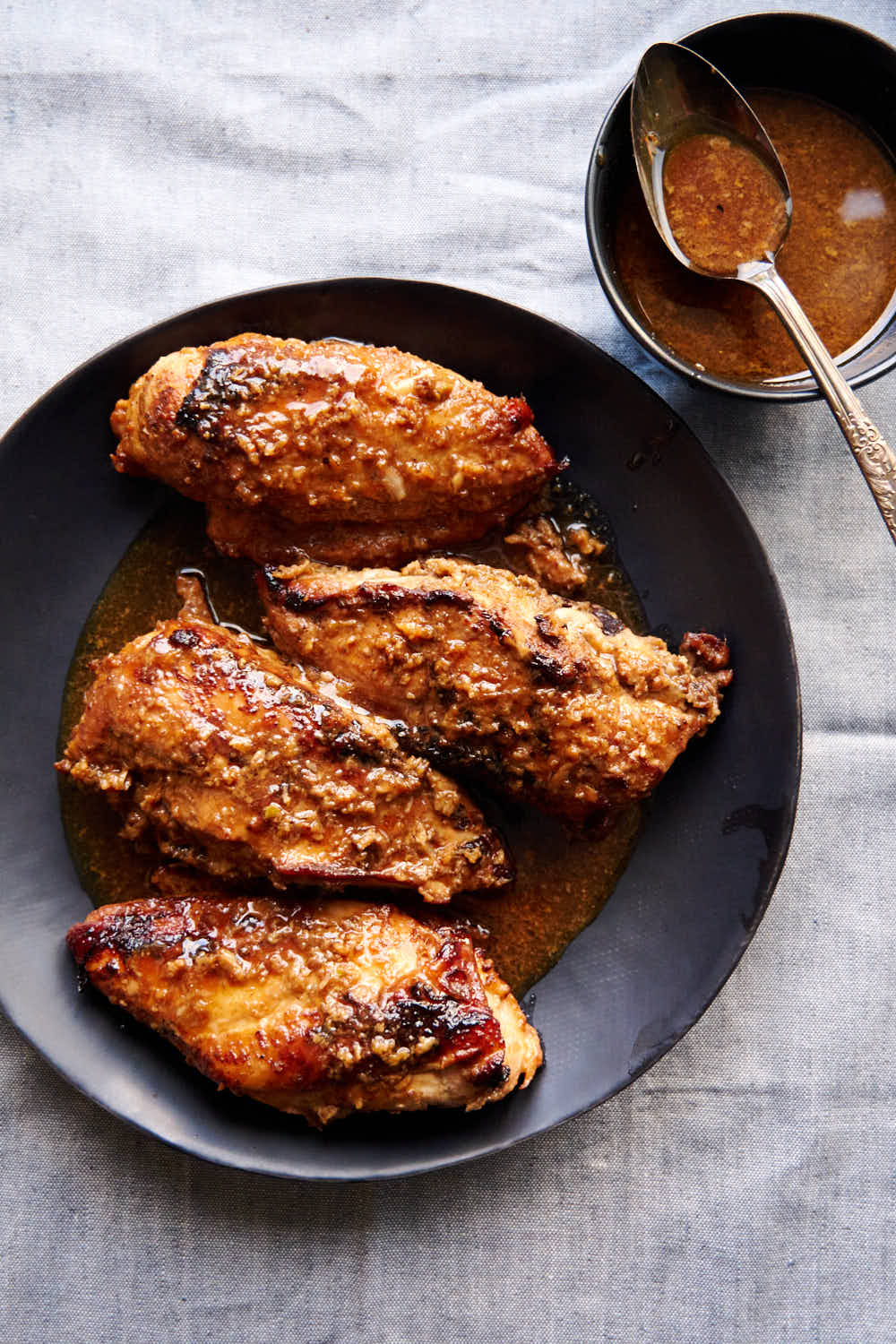

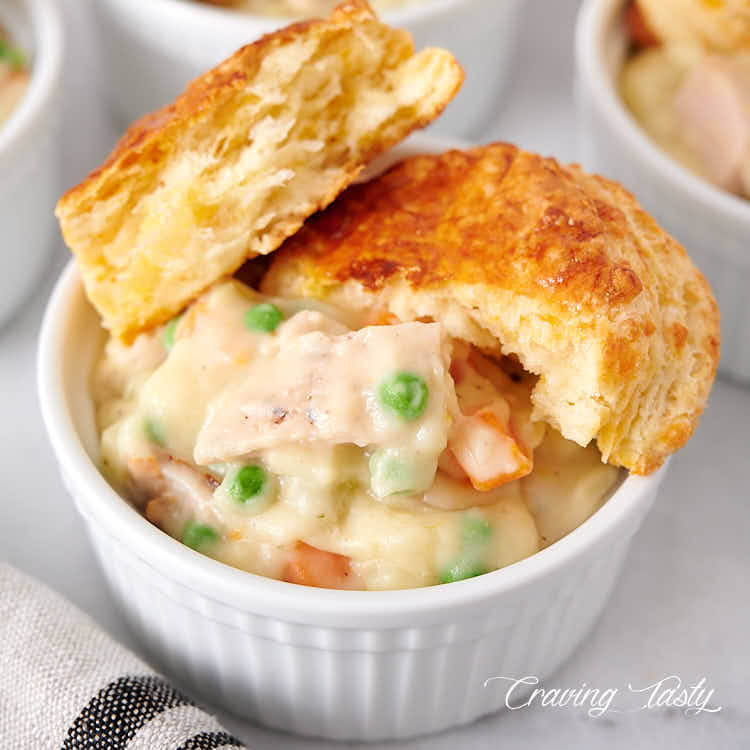

angiesrecipes says
This is the BEST chicken recipe that I have ever seen! Can't wait to try it! Thanks!
Michelle Nazario says
I made this today and it was amazing. I will definitely make this again!
victor says
Thank you for your feedback, Michelle. My family liked this chicken so much that we've made it 4 times over the past two weeks or so. I made chicken tabaka a few times a long time ago but somehow it did not impress us as much. I have a feeling that it's the sauce that made such a big difference. It's delicious. I also cook the chicken at a slightly lower temperature which slows down browning and allows the meat get very tender while retaining its juiciness. I also apply less pressure on the chicken then before. Too much pressure makes the meat drier I think.
victor says
Thank you for your feedback, Michelle. My family liked this chicken so much that we've made it 4 times over the past two weeks or so. I made chicken tabaka a few times a long time ago but somehow it did not impress us as much. I have a feeling that it's the sauce that made such a big difference. It's delicious. I also cook the chicken at a slightly lower temperature which slows down browning and allows the meat get very tender while retaining its juiciness. I also apply less pressure on the chicken than before. Too much pressure makes the meat drier I think.